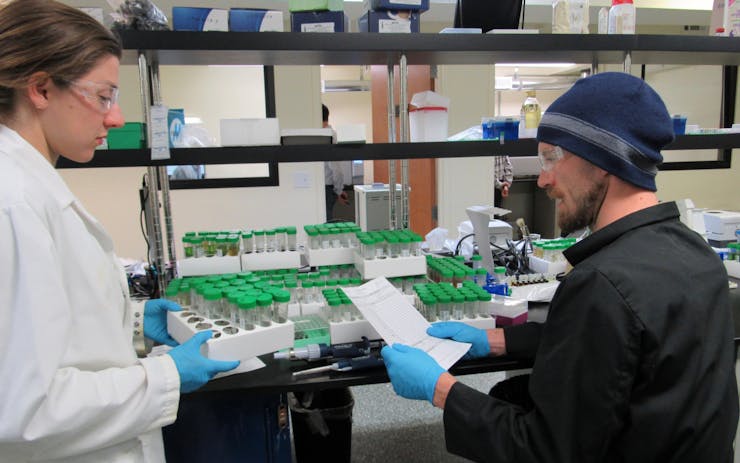Cannabis is going from the Dark Ages to Star Trek pretty rapidly these days.
Witness California, where on Sunday, July 1, the promise of clean, pesticide-free marijuana became a reality literally overnight.
Some dispensary shelves have gone nearly bare this month as brands line up for unprecedented quality control screening. The cannabis that is making it to the shelves—from the likes of Korova and ButterBrand—is going for as much $70 per eighth-ounce right now, and it’s cleaner than California’s food.
Voter-mandated under California legalization Proposition 64, such high standards are a boon for the nation’s most health-conscious consumers. Just think of the millions of metric tons of pesticides we’ve already collectively smoked. Blegh.
But it’s also a huge gift to the state’s tiny cannabis lab industry, which started in apartments and vans more than a decade ago and is now exploding amid record demand for testing in the nation’s largest legal cannabis market.
‘Can labs meet California demand, or will it blow them up?’, I ask one veteran lab expert, John Oram, formerly of CW Analytical.
“The answer is yes to both of those questions,” he laughs. “The labs are going to be slammed.”
“I’m working 12-hour days,” says 35-year-old Oakland resident Richard Hartnell, while plunging a syringe into a plastic vial at EVIO Labs in Berkeley.
A Roaring Cannabis Sector

A ground cannabis sample is prepared for analysis at EVIO Labs in Berkeley, Calif. (Photo David Downs/Leafly)
EVIOS’ main lab floor is roaring with liquid chromatography machines and fans this summer. The air is spiked with the bright pinene smell of freshly ground weed. Merely visiting constitutes aromatherapy. Four lab techs float around the large white room in coats and glasses, silently prepping and processing new samples coming in from the mail or couriers.
Labs are the key quality controllers in the state’s legal cannabis supply chain. Trained technicians and investors have hit payday for two main reasons: California is a state of 38 million people with just 31 cannabis lab licensees, and only a dozen or so California cities or counties even allow cannabis labs to exist.
Lab tech Brenda Grate, 29, says she is stoked as she mixes raw, ground flower samples with a solvent for extraction and analysis. She is down from EVIOS’ Humboldt lab to help with the overflow work.
To get hired, Grate cold-called local cannabis companies as she finished her undergrad degree in biology and soil science at Humboldt State. She hit it off with some local lab owners, who were both parents of pediatric cannabis patients.
“I really love it. I’m excited to be part of a new medicine,” she said.The Golden State Just Got More GoldenNational chain EVIO Labs bought three-year-old Berkeley lab C3 and the Humboldt lab Leaf Detective this January, part of a roll-up of local licensees in the fast-moving sector. EVIO Labs is planning more California labs and satellite offices, aiming to have 18 outlets nationally by end of year.
“We are in a hiring frenzy,” says Chief Science Officer Tobias Paquet. “Demand is up 100% this month and we expect it to double every month.”
EVIOS-Berkeley isn’t profitable yet, he says, as he looks out across his lab floor, but “we are poised to be.”
“We’re going to be in high demand and short supply.”
That is an understatement.
No one knows how labs will handle the state’s demand — because no one knows exactly how much demand there is. The limited, licensed adult-use retail market is centered around 350 stores statewide. Bureau of Cannabis Control officials are watching warily. Most marijuana still flows around and outside of this system, but it’s already eating into the black market significantly.
One bright spot: Many leading labs added capacity in preparation for July 1. Anresco Laboratories in San Francisco and CW Analytical in Oakland both seem ready for the workload.
“I know they’re ready for this and scaling up,” said John Oram, a former CW Analytical founder now CEO of Bloom Innovations, a product-maker.
The question is: Did labs scale up enough? New people and machines cost money, so some labs have been trying to add capacity as needed—feathering the throttle, as it were. Now the demand is suddenly sobering.
“It’s definitely a lot—it’s big. It’s a big influx,” says Joshua Richard, cannabis marketing manager at Anresco.
“We’ve seen the storm coming. It’s exciting and somewhat daunting,” says Paquet.
No Easy Test

Cannabis samples sit ready for analysis at EVIOS Labs in Berkeley, Calif. (Photo: David Downs | Leafly)
Overnight, the list of things a lab must test for has doubled. It includes 67 pesticides, 11 cannabinoids, residual solvents, mold, mildew, fungus, dirt, and water weight. By law, California retailers can’t sell weed that’s too wet or dry, let alone contaminated.
We’re pushing the limits of the technology
Paquet called the new state regulations “very challenging. We’re pushing the limits of the technology.”
Fail levels for pesticides and residual solvent can be measured in the parts per billions. That’s so minuscule, it borders on undetectable with current lab tech.
Most pesticides degrade pretty fast in nature, and they’re even harder to catch in a lab machine, Paquet said.
Plus, pesticides are usually tested in water samples, not in complex food like an infused cheese pizza. No standardized lab procedures exist to measure residual pesticides in such products. That’s why California labs must themselves become certified under the International Organization for Standardization (ISO) by January 2019. Later this year, even tighter testing rules bite down. Soon, California herb must pass screens for heavy metals and fungal toxins. It’s the dawn of clean weed in the Golden State.
As for consumers, Paquet said he expects California to go the way of Oregon. Initially, prices rose and supplies fell as testing rules first bit down. Then production of clean, compliant cannabis ramped up, and prices crashed.
Today, Oregon cannabis is going for historic lows, with some on sale for $50 per ounce—retail.





